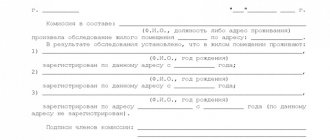Establishment of paternity after the death of a parent is carried out exclusively in court. An important factor is the direct recognition of the child as a deceased person during his lifetime. In addition, when establishing paternity after the death of the father, the procedure can only be started if there is evidence certifying that the child was born from the deceased parent. Judicial practice on such disputes is presented both in relation to young children and those born before 1968; in the latter case, the plaintiff must have evidence that the minor was fully dependent on the alleged father until his death.
Paternity Establishment Procedure
Persons who can file a claim to establish the fact of recognition of paternity in court:
- mother of the child;
- a person who is dependent on a child who has not reached the age of majority;
- the official guardian of the child, provided that the latter has not reached the age of majority;
- directly the child himself upon reaching 18 years of age.
According to the civil procedural legislation, this category of cases is classified as special and has its own procedure for consideration:
- The subject of the dispute is not the violated or disputed rights, but only the interests of the applicant.
- Only the plaintiff and interested citizens are present in the consideration of the case, who provide an explanation of the case.
- This process does not provide an opportunity to refuse or accept a claim, or to file a motion to secure it.
- Since this category of cases does not have a defendant, the application is submitted by the plaintiff at his place of residence.
- A statement of claim to establish paternity posthumously is filed either with a magistrate or with a court of general jurisdiction, depending on the situation. For example: if it is necessary to formalize the child’s right to the inheritance of a deceased father, the claim is filed in a court of general jurisdiction; if we are talking about issuing a social pension or benefits, the application should be submitted to a magistrate for consideration.
- The statement of claim should describe the current situation in detail, in particular indicate the circumstances and reasons that prompted the initiator to begin the procedure for establishing paternity. Copies of the following documents should be attached to the statement of claim: the child’s birth certificate;
- a certificate from the registry office confirming the absence of marriage to the deceased father of the child;
- death certificate or other document confirming the fact of death of a person;
- certificate of cohabitation, if available;
- a receipt confirming payment of the state fee;
- proof of paternity of a specific person.
The main evidence for recognizing paternity posthumously is documents and testimony. Thus, in accordance with Article 49 of the Family Code of the Russian Federation, as confirmation, the plaintiff may need to provide:
- personal correspondence of the deceased with the mother of the child or with the child himself, from which it becomes clear that the person recognizes his child and does not renounce him (for example, letters written by the alleged father of the child);
- a written statement from a deceased citizen proving his paternity indirectly - for example, enrolling a child in clubs and sections, signing an agreement in preschool and school institutions;
- joint photographs and videos.
Witnesses can be close relatives of the child’s deceased father, neighbors at the place of residence, acquaintances and other persons who can confirm the fact of the father’s participation in the child’s life. State bodies, for example, guardianship and trusteeship authorities, can also act as witnesses. In addition, medical documents - the results of DNA analysis - can serve as evidence, but this procedure can only be carried out with the consent of a close relative of the deceased person, for example, his parents, brothers or sisters.
How to prove paternity in court?
Most often, genetic testing is performed to establish paternity. The petition can be submitted during the process. This procedure is quite expensive, but if the result is positive, all legal costs can be recovered from the defendant. Blood and saliva tests most accurately confirm the genetic establishment of paternity. Based on the medical examination, the judge makes his decision.
But this is not the only way to prove that a specific person is the parent of a child. As confirmation, you can attach letters, photos in which the defendant recognizes the baby as his son or daughter, and witness statements. The fact of living with the child’s mother and running a joint household with her can also have an impact on the outcome of the case.
Is it possible to object to a claim to establish paternity?
There are often cases where applications filed by the mother of a child to establish the paternity of a deceased spouse have the most complex review process, subject to certain circumstances. In particular, such circumstances may include counter-objections filed by close relatives of the deceased, including the official wife. The fact of relationship is confirmed by photographs, letters and testimony only if the deceased father was not officially married; in the opposite situation, it is much more difficult to prove paternity. As a rule, simply evidence and witness testimony is not enough for the court to make a decision if the alleged father lived in another family and a DNA test is required.
Important! Russian judicial practice shows that if there is a counterclaim to a filed application to establish paternity, in 95% of cases the court, when making a decision, is guided only by the results of a DNA analysis.
Why is it necessary to establish paternity posthumously?
There is a moral side to the issue - the child, albeit in this form, will still know about his father. But often this aspect fades into the background - an application to establish the fact of paternity is submitted in order to:
- enter into inheritance rights, since the child is the heir of the first priority;
- receive a survivor's pension;
- if a child has neither a father nor a mother, then in this case he can receive the status of an orphan, which also gives certain social privileges.
If during his lifetime a man wanted to acknowledge paternity, but simply did not have time to do so, then the posthumous establishment of biological kinship will occur according to a simplified scheme. If the potential father completely refused to recognize the child, then the judicial procedure will take place on a general basis.
DNA paternity testing after the death of a parent
Today, a DNA test is a fairly common procedure that allows one to establish paternity, both with a living parent and after his death. In the case of posthumous paternity determination, DNA analysis is carried out only after a court decision in a specific clinic, which is indicated in the document. The procedure is carried out in compliance with sanitary and legal standards; materials from close relatives are used as biomaterial, as well as a blood test from a deceased person, if he took it during his lifetime. A paternity test gives a probability of 99% of cases, which significantly increases the chances for the plaintiff of a positive outcome of the case. After receiving the result, the documents are sent to the court, which sets a new date for the consideration of the case, where a decision is made to satisfy the plaintiff’s claims or deny them. If the court makes a positive decision, the plaintiff receives this decision and applies to the registry office with an application, attaching the specified decision and the child’s birth certificate to the document. A few days later, on the basis of a court verdict, the plaintiff receives from the registry office a new certificate of paternity, which gives the right to claim the inheritance of the deceased father and to receive state benefits.
The legislative framework
The procedure for posthumous paternity establishment is regulated by the following legislative acts:
- RF IC – Article 50.
- Guidelines of the Ministry of Health No. 98/253.
- Federal Law “On State Judicial Activities”.
- “The procedure for conducting and organizing forensic medical examinations in government organizations.”
Additional regulations can also be used - from the Code of Civil Procedure of the Russian Federation, the Civil Code of the Russian Federation, and the Criminal Code of the Russian Federation.
Financial expenses
If the process takes place in a special order, then it will not bring any special material costs.
The child's legal representatives are exempt from paying tax, and genetic testing is not required in this case.
In case of a lawsuit, you cannot do without the costs associated with paying for a lawyer. Carrying out a genetic examination will also become a serious financial test for the initiator of the process.
The losing party is obliged to fully pay for the services of a lawyer and examination.
In lawsuit proceedings (the father did not recognize paternity)
When a dispute arises about the right to inherit the property of a deceased man, the matter will be considered in a lawsuit. Paternity is proven in court on the basis of a statement of claim.
The applicants are:
- mother of the child;
- guardian;
- the child himself;
- another person who is dependent on the child.
If the evidence presented by the plaintiff is insufficient, a genetic examination may be necessary, to which the mother gives consent.
It happens that a man’s relatives insist on an examination in order to prove or refute paternity.
There is no statute of limitations for establishing paternity.
What's next?
The court accepts documents, examines them and, if everything is as required by procedural requirements, sets a date for the trial. During this stage:
- hear the parties;
- hear witnesses;
- decide to conduct a DNA examination;
- Based on all the facts obtained, including the results of genetic research, a decision is made.
If the court determines that the person indicated in the claim is the father of the child, then a corresponding court order is issued, and a new certificate is issued at the registry office. If the evidence is not significant for the court, or the examination shows a negative result, then the fact of paternity will not be established posthumously, and the child will not be legally recognized as a relative of the deceased person.
Proper plaintiff
The law limits the list of persons who can go to court.
Proper plaintiffs
| No. | Proper plaintiff |
| 1 | Mother of a minor child |
| 2 | Legal representative of a minor child (guardian, trustee) |
| 3 | Administration of the orphanage (in relation to the organization's pupil) |
| 4 | Guardian of an adult incompetent child |
| 5 | The child himself, over 18 years old |
The authority of the plaintiff must be documented. For example, the mother provides the child’s birth certificate and her civil passport. If the minor has reached 14 years of age, then his passport is additionally attached.
How to make an application correctly?
The statement of claim must include the following information:
- where and from whom the claim is filed;
- description of the circumstances of the case - what kind of relationship the parties had, when the child was born, his full name; whether the father was going to admit this fact, his full name, date of death (presumed, if they don’t know for sure);
- requirement to establish paternity;
- list of attached documents;
- if there are witnesses, then a petition to hear them;
- date and signature.
The claim is submitted in three copies: to the plaintiff, the defendant, and the judge. The state fee, since this is a claim in the interests of a minor child, is not paid.
The claim is filed in the magistrate's court at the place of residence of the parent and the child.
Where to contact?
Whatever the purpose of the plaintiff filing a petition for recognition of paternity after death, this application is considered exclusively in court.
If a man acknowledged kinship during his lifetime, the application will be sent to civil proceedings.
And if the father did not recognize the blood connection, the case will be referred to the lawsuit.
Special order
Civil proceedings are a simpler way to establish paternity.
According to Article 50 of the RF IC, the case is considered in a special manner in the following cases:
- if the citizen recognized his child during his lifetime;
- if no official relationship has been registered between the father and mother of the child;
- if there are witnesses in the process who can confirm the fact that the deceased recognized a relationship with the child;
- If the subject of the trial is not the restoration of rights, but the protection of the interests of the plaintiff.
If during court hearings a dispute about inheritance rights arises, the applicant’s claim will be denied, of which he will be notified in writing with an explanation of the refusal.
The judge takes into account all the circumstances of the case and makes a decision based on them.
Issuance of an amended birth certificate
A positive court decision, which established the fact of voluntary recognition of paternity during life, is not all.
According to Art. 268 of the Code of Civil Procedure of the Russian Federation, a court decision is a document that confirms the fact of paternity. But if this fact is subject to state registration or serves as the basis for state registration, a court decision cannot replace a document (certificate) issued by the registration authority (ZAGS).
Thus, after receiving a positive court decision, you need to contact the registry office to carry out the registration procedure - entering data about the father into the registration records of establishing paternity and the birth of the child, as well as issuing a new birth certificate (according to Article 48, paragraph 3 of Art. 54, paragraph 1 of article 57 of the Federal Law “On acts of civil status” No. 143 of November 15, 1997).
To carry out the registration procedure, the following documents will be required:
- passport of the applicant (parent, guardian, trustee, legal representative of a minor child or the most adult child);
- the child's previous birth certificate;
- court decision;
- a receipt for payment of the state fee according to the registry office details in the amount of 650 rubles (according to Part 5, Clause 1, Article 333.26 of the Tax Code of the Russian Federation).
Expert opinion
Semyon Frolov
Lawyer. 7 years of experience. Specialization: family, inheritance, housing law.
From a procedural point of view, establishing a legal fact is not a complex or lengthy judicial procedure. But many naturally have difficulties associated with collecting documents and the process of proof, preparing a legally competent statement, and attending court hearings.
If you have any questions or need individual legal support, you can get it for free.
Write to the 24-hour legal support chat or call the hotline. Our lawyer will contact you and advise you. Attention!
- Due to frequent changes in legislation, information sometimes becomes outdated faster than we can update it on the website.
- All cases are very individual and depend on many factors. Basic information does not guarantee a solution to your specific problems.
That's why FREE expert consultants work for you around the clock!
- via the form (below), or via online chat
- Call the hotline:
- Moscow and the Region
- St. Petersburg and region
- FREE for a lawyer!
By submitting data you agree to the Consent to PD Processing, PD Processing Policy and User Agreement.
Anonymously
Information about you will not be disclosed
Fast
Fill out the form and a lawyer will contact you within 5 minutes
Tell your friends
Rate ( 2 ratings, average: 3.50 out of 5)
Author of the article
Irina Garmash
Family law consultant.
Author's rating
Articles written
612
Algorithm of actions when challenging paternity
To challenge paternity and make changes to the civil registry, you need to:
- Prepare a statement of claim for the court and collect evidence. The evidence base is the responsibility of the plaintiff, because a claim without grounds will be immediately rejected by the court or left without progress.
- Submit documents to the court, wait for confirmation that the claim will be accepted for proceedings.
- Come to court.
- If the defendant agrees with the claim voluntarily, the demands are satisfied without examining the evidence base and ordering a genetic examination. The decision is made automatically at the first meeting.
- Receive a court decision after it comes into force (within 30 days).








